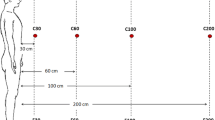Abstract
Time-course study of individual dose equivalents of 2-deoxy-2-[F-18]fluoro-d-glucose positron emission tomography (18F-FDG PET) was conducted in different hospital workers, and the daily work duties were analyzed. For the measurements, a semiconductor dosimeter was used. The values at intervals of 1 min and 1 h, the monthly cumulative and daily cumulative doses, and trend graphs were acquired with dedicated software and displayed on the reader. The following radiation workers with duties involving maximum external exposure work were included: doctors making diagnoses (4.8 μSv/procedure), nurses removing injection needles (3.1 μSv/procedure), pharmacists performing quality control tests (2.9 μSv/procedure), nuclear medicine technologists assisting patient positioning (6.5 μSv/procedure), and cyclotron engineers performing daily checks (13.4 μSv/procedure). The results of analysis of daily work duties revealed the influencing factors of external exposure dose. To reduce the external exposure dose, investigators should shorten the patient’s contact time with the 18F-FDG source or patient tracer.





Similar content being viewed by others
References
Melcher CL. Scintillation crystals for PET. J Nucl Med. 2000;41:1051–5.
Lodge MA, Badawi RD, Gilbert R, Dibos PE, Line BR. Comparison of 2-dimensional and 3-dimensional acquisition for 18F-FDG PET oncology studies performed on an LSO-based scanner. J Nucl Med. 2006;47:23–31.
Chiesa C, De Sanctis V, Crippa F, Schiavini M, Fraigola CE, Bogni A, et al. Radiation dose to technicians per nuclear medicine procedure: comparison between technetium-99m, gallium-67, and iodine-131 radiotracers and fluorine-18 fluorodeoxyglucose. Eur J Nucl Med. 1997;24:1380–9.
Bayram T, Yilmaz AH, Demir M, Sonmez B. Radiation dose to technologists per nuclear medicine examination and estimation of annual dose. J Nucl Med Technol. 2011;39:55–9.
Harding LK, Harding NJ, Warren H, Mills A, Thomson WH. The radiation dose to accompanying nurses, relatives and other patients in a nuclear medicine department waiting room. Nucl Med comm. 1990;11:17–22.
Benatar NA, Cronin BF, O’Doherty MJ. Radiation dose rates from patients undergoing PET: implications for technologists and waiting areas. Eur J Nucl Med Mol Imaging. 2000;27:583–9.
Covens P, Berus D, Vanhavere F, Caveliers V. The introduction of automated dispensing and injection during PET procedures: a step in optimisation of extremity doses and whole-body doses of nuclear medicine staff. Radiat Prot Dosimetry. 2010;140:250–8.
Yasuda H, Fujitaka K. Efficiency of a radiophotoluminescence glass dosemeter for low-earth-orbit space radiation. Radiat Prot Dosimetry. 2002;100:545–8.
Suzuki A, Suzuki T, Takahashi M, Nakata T, Murayama T, Tsunoda M. Characteristics of OSL dosimeter for individual monitoring for external radiation. JAEA-Technology. 2014;49:1–8 (In Japanese).
Cemusova Z, Ekendahl D, Judas L. Testing of the D-Shuttle personal dosemeter. Radiat Meas. 2017;106:214–7.
Yamaguchi Y, Saito T. Secular and angular response changes of semiconductor-type electronic pocket dosimeter. Jpn J Radiat Magag. 2004;3:21–6 (In Japanese).
Nakamura F, Kanno T, Okada H, Yoshikawa E, Andou I, Futatsubashi M, et al. Measurement of radiation exposure to a PET institution driver from patients injected with FDG. Jpn J Radiol Technol. 2006;62:1105–10 (In Japanese).
Tsujiguchi T, Shiroma Y, Suzuki T, Tamakuma Y, Yamaguchi M, Iwaoka K, et al. Investigation of external radiation doses during residents' temporal stay to Namie town, Fukushima prefecture. Radiat Prot Dosimetry. 2019. https://doi.org/10.1093/rpd/ncz107.
Murayama K. Outline of D-Shuttle and its application. Radioisotopes. 2018;67:452–60.
Deji S, Nishizawa K. Effects of high frequency electromagnetic fields emitted from digital cellular telephones on electronic pocket dosimeters. Jpn J Radiat Magag. 2003;2:33–7 (In Japanese).
ICRP Publication 103. The 2007 recommendations of the International Commission on radiological protection. Ann ICRP. 2007;37:2–4.
Levinger R, Budinger TF, Watson EE. 1991. MIRD primer for absorbed dose calculations: Revised. New York: The Society of Nuclear Medicine, pdf. Accessed 17 Oct 2019.
Choju K. Gamma-ray shielding lead glass for PET facilities “Pro-GR”. New Glass. 2006;21:65–9 (In Japanese).
International Atomic Energy Agency. Occupational radiation protection: general safety guide. IAEA safety standards series No.GSG-7. Vienna: International Atomic Energy Agency; 2018. https://www-pub.iaea.org/MTCD/Publications/PDF/PUB1785_web.pdf.
Acknowledgements
We would like to thank the staff of the Advanced Clinical Research Center of Fukushima Medical University. A part of this work was supported by the Research Center for Radiation Disaster Medical Science.
Author information
Authors and Affiliations
Corresponding author
Ethics declarations
Conflict of interest
The authors declare that they have no conflict of interest.
Statement of human rights
All procedures in the study involving human participants were in accordance with the ethical standards of the institution research committee and with the 1964 Declaration of Helsinki and its later amendments or comparable ethical standards. For this type of study, formal consent was not required.
Statement of animal rights
This article does not contain any studies with animals performed by any of the authors.
Informed consent
Informed consent was obtained from all individual participants included in the study.
Additional information
Publisher's Note
Springer Nature remains neutral with regard to jurisdictional claims in published maps and institutional affiliations.
About this article
Cite this article
Takahashi, Y., Hosokawa, S., Tsujiguchi, T. et al. Time-related study on external exposure dose of 2-deoxy-2-[F-18]fluoro-d-glucose PET for workers’ safety. Radiol Phys Technol 13, 98–103 (2020). https://doi.org/10.1007/s12194-019-00548-0
Received:
Revised:
Accepted:
Published:
Issue Date:
DOI: https://doi.org/10.1007/s12194-019-00548-0




